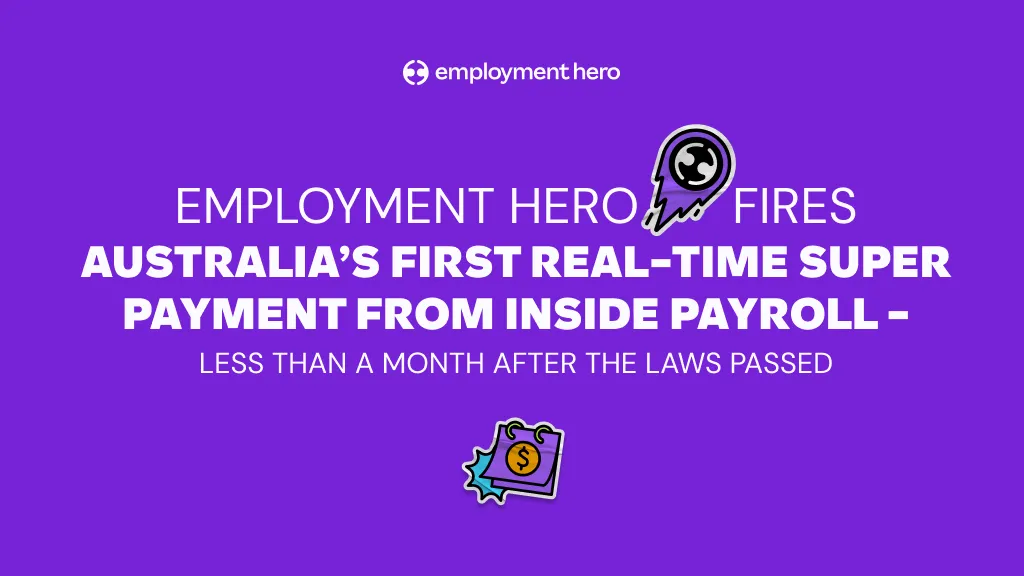Understanding Parental Leave In Australia
Published
Understanding Parental Leave In Australia
Welcoming a new child is one of life’s biggest milestones, and as an employer, you play a vital role in supporting your team through this transition. Understanding parental leave entitlements and your responsibilities under the Fair Work Act is essential to creating a fair and compliant workplace.
With evolving legislation and increasing expectations around workplace flexibility, staying informed has never been more important. From managing eligibility and planning coverage to supporting a confident return to work, this guide outlines what Australian employers need to know about managing parental leave effectively.
What’s in this parental leave guide?
Are you getting your head around the latest changes to parental leave or simply wanting to improve your existing entitlements? Understanding your employer obligations under the Fair Work Act is the first step to supporting your people through this life-changing milestone.
This guide explains everything you need to know as an employer when it comes to parental leave, plus additional information around this complex topic. In here, you’ll find important information on:
- What is parental leave, who’s eligible and the duration.
- How to manage parental leave extensions.
- The role of ‘keeping in touch’ days.
- Supporting an employee’s return to work after parental leave.
Whether you’re updating your workplace policies, managing your first parental leave request or simply wanting to get it right with all the recent changes, this guide is here to make the process easier for you and your team.
Download the guide by filling out the form on the right.

What are the different types of parental leave?
Parental leave can be tricky to navigate, especially with different types of leave and recent changes now in effect. Whether it’s government-funded, unpaid or employer-funded leave, understanding what’s what helps ensure your team gets the support they need, all while managing your legal obligations.
Paid parental leave (government-funded)
The government’s scheme provides financial support to eligible primary carers at the national minimum wage rate. It is a means-tested benefit available for lower earners. This entitlement exists separately from any employer-provided benefits and doesn’t impact an employee’s workplace rights to unpaid leave under the Fair Work Act.
What does the Australian government say about parental leave?
The Australian government has taken a clear and supportive stance on parental leave. Through a combination of legal protections and funded support, it’s working to ensure that new parents can take the time they need, without risking their income or job.
Under the Fair Work Act, eligible employees are entitled to 12 months of unpaid parental leave, with the option to request an additional 12 months of leave. It’s a legal right that gives families breathing room during a big life change and helps employers provide stability.
Importantly, the government’s paid parental leave scheme is designed to work alongside employer-funded leave, not replace it. This gives your employees the chance to combine both entitlements and get the best possible support during this time.
There’s also flexibility built into the system. Features like ‘keeping in touch’ days allow new parents to stay engaged with work, whether that means attending a team meeting or doing a short handover, without losing their payments.
Unpaid parental leave
Unpaid parental leave is a legal entitlement under Australia’s National Employment Standards (NES), designed to give eligible employees time away from work to care for their new child, without risking their job.
If your employee has worked with you for at least 12 months before their baby is born or adopted, they’re entitled to 12 months of unpaid parental leave and the right to request an additional 12 months (which you can approve or decline on reasonable business grounds).
Either parent can take this leave, and it applies to full-time, part-time and eligible casual employees.
There’s also the option for flexible unpaid parental leave, where an employee can take up to 120 days flexibly within 24 months of the child’s birth or adoption. These can be taken as single days or in blocks, offering greater adaptability for a gradual return to work.
As an employer, you don’t need to pay during this time, but you do need to ensure their role is held open and that you’re meeting your obligations under the Fair Work Act.
Supporting this leave helps demonstrate that you value work-life balance and are committed to your team’s long-term well-being.
Employer-funded parental leave
Employer-funded parental leave is a powerful way to support your people through major life transitions. While not required by law, many Australian companies opt to offer paid parental leave as a strategic investment in their culture, people and long-term success.
Providing paid leave for new parents can help retain top talent, improve employee satisfaction and build a workplace that values balance and inclusivity. It also signals that your business supports working families by offering practical benefits.
Typically, employer-funded parental leave includes:
- A defined period of paid leave for primary carers (often 6–12 weeks at full pay).
- Paid leave for secondary carers, such as partners, ranging from a few days to a few weeks.
- Policies that may include eligibility requirements (e.g. minimum tenure).
- Options to use this leave alongside or in addition to the government’s Paid Parental Leave scheme.
Some businesses offer the leave upfront, while others use it to top up the government-funded portion. Many also support return-to-work transitions with phased hours or flexible arrangements.
Should an employer be offering additional parental leave or pay?
Employers are able to offer additional parental leave pay, without causing their workers to forfeit government PLP. Employees are able to accept both.
Additional parental payments are referred to as ‘employer-funded paid parental leave’.
Any employer-funded paid parental leave that you would like to offer to your staff should be explicitly stated in an agreement, contract or policy. If you choose to go down this route, we strongly recommend you seek advice from our HR Advisory Service to help ensure you have in place a clear and compliant policy.
In terms of whether you should offer employer-funded paid parental leave or not, there’s no clear answer. This decision is at your business’ discretion to consider.
If your business has the budget to offer it as an employee benefit, it could help you attract and retain more staff. Increasingly, companies that have enough capital are choosing to offer this to show their value of working parents.
If you don’t have the budget, there are other ways to support working parents beyond their parental leave and pay periods.

Supporting an employee’s return to work after parental leave
When an employee returns from unpaid parental leave, they’re entitled to return to their pre-leave position. If that role no longer exists, you must offer a suitable alternative with similar pay and status if one exists. If any role changes are agreed, you’ll want to update your employee and confirm their duties, hours and reporting lines in writing.
Employees who moved into a safe job or reduced their hours during pregnancy are entitled to return to their original position and working hours once they come back from parental leave.
For any major changes in the workplace that occur while an employee is on parental leave (e.g. restructures or redundancies), you’re required to consult them.
Supporting flexible work requests
It’s common for parents and carers to often seek flexible work arrangements after returning to work from parental leave.
Employees can formally request extra flexibility, such as part-time hours, adjusted start and finish times or remote work options. Eligible employees can make this request if they:
- Are the parent, or have responsibility for the care of, a child that is school age or younger and,
- Have worked in your business for at least 12 months.
Employees must submit their request in writing and you must respond within 21 days. You’ll need to clearly state if the request was approved or denied, and if you refuse, you’ll need to explain your reasonable business grounds in writing.
Employment Hero can help you support your team through life’s big milestones
As you can see, parental leave in Australia can be a lot for employers to manage, with layers of rules covering unpaid leave entitlements, government-funded leave, keeping in touch days, safe-job obligations and flexible work requests. We know that navigating these requirements while staying compliant can be time-consuming and stressful.
Thankfully, Employment Hero’s Employment Operating System makes it simple. Within the platform, you can create, manage and store your parental leave policies in one central, secure location. Automate the entire process from drafting policies to sharing them with employees, while keeping documentation, approvals and acknowledgements neatly recorded and accessible anytime. You can even set reminders for policy reviews, making sure nothing slips through the cracks.
Need extra confidence? Our HR Advisory service can help you navigate your employer obligations, making sure you’re prepared for every request. They’ll guide you through your employer obligations under the Fair Work Act and National Employment Standards (NES), so you can support your people through the next chapter of their life.
Keen to learn more about how we can support you and business? Get in touch with one of our business specialists today to learn more.
Disclaimer: The information in this guide is current as at 13 October 2025 and has been prepared by Employment Hero Pty Ltd (ABN 11 160 047 709) and its related bodies corporate (Employment Hero). The views expressed in this guide are general information only, are provided in good faith to assist employers and their employees, and should not be relied on as professional advice. The Information is based on data supplied by third parties. While such data is believed to be accurate, it has not been independently verified and no warranties are given that it is complete, accurate, up to date or fit for the purpose for which it is required. Employment Hero does not accept responsibility for any inaccuracy in such data and is not liable for any loss or damages arising either directly or indirectly as a result of reliance on, use of or inability to use any information provided in this guide. You should undertake your own research and to seek professional advice before making any decisions or relying on the information in this guide.
Register for the guide
Related Resources
-
 Read more: 8 Email Holiday Templates for Every Workplace
Read more: 8 Email Holiday Templates for Every Workplace8 Email Holiday Templates for Every Workplace
Struggling to write your out-of-office message? Copy our 8 free holiday email templates for Christmas and New Year to set…
-
 Read more: Product Update: November 2025
Read more: Product Update: November 2025Product Update: November 2025
Welcome to the November 2025 product update from the Employment Hero team. We’ve got lots to share around Workflows, Rostering,…
-
 Read more: Payday Super pressure eased: Employment Hero fires Australia’s first real-time super payment from inside payroll – less than a month after the laws passed
Read more: Payday Super pressure eased: Employment Hero fires Australia’s first real-time super payment from inside payroll – less than a month after the laws passedPayday Super pressure eased: Employment Hero fires Australia’s first real-time super payment from inside payroll – less than a month after the laws passed
One month on, Employment Hero, Zepto and OZEDI deliver the first payroll-embedded super-clearing payment over the New Payments Platform (NPP),…























